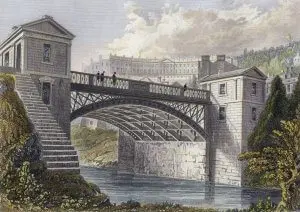I realised that I haven’t mentioned The Old Vicarage and the clergy of Combe Down in the blog.
That’s an error as as the house was designed by Henry Edmund Goodridge (1797 – 1864) who designed one of Bath’s iconic monuments: Beckford’s Tower. He also designed one of the world’s earliest retail arcades The Corridor in central Bath.
He designed Cleveland Bridge at the site of a Roman ferry crossing, linking the A4 London Road with the A36. It’s a cast iron arch bridge with lodges like miniature Greek temples at each corner and was was built in 1827 by William Hazledine. Oh, and he had also designed Holy Trinity church.
The Old Vicarage was used by the vicars of Combe Down until 1974 when it was sold to Dr John (Jack) Ferens Turner (1930 – 2002) and his wife Dr Anne Curtis Turner (née Pyke) (1939 – 2006).
There have been some interesting ministers living at The Old Vicarage, such as Rev George William Newnham (1806 – 1893) who was Vicar from 1842 – 1877. He was married 3 times and had 17 children!
His third wife Harriette Helen White (1820 – 1889) set up what became the Institution for Idiot Children and those of Weak Intellect at Rockhall House on Combe Down. He also started the Combe Down allotments.
There was Rev Carr Glyn Acworth (1842 – 1928) who was Vicar from 1877 – 1890. He was also was married 3 times but he had no children.
Rev Alfred Richardson (1853 – 1925) was vicar from 1902 – 1914. After he retired he wrote: An historical guide to Monkton Combe, Combe Down and Claverton with Rev David Lee Pitcairn (1848 – 1936) who was vicar of Monkton Combe from 1883 – 1914 and also a great grandson of Arthur Guinness (1725 – 1803) – the brewer.
Ven Albert Bushnell Lloyd (1871 – 1946) was vicar from 1930 – 1933. He was a missionary and Archdeacon of Western Uganda. His written works include: Uganda to Khartoum (1906), In Dwarf Land and Cannibal Country (1907), Dayspring in Uganda (1921) and Apolo of the Pygmy Forest (1923).


